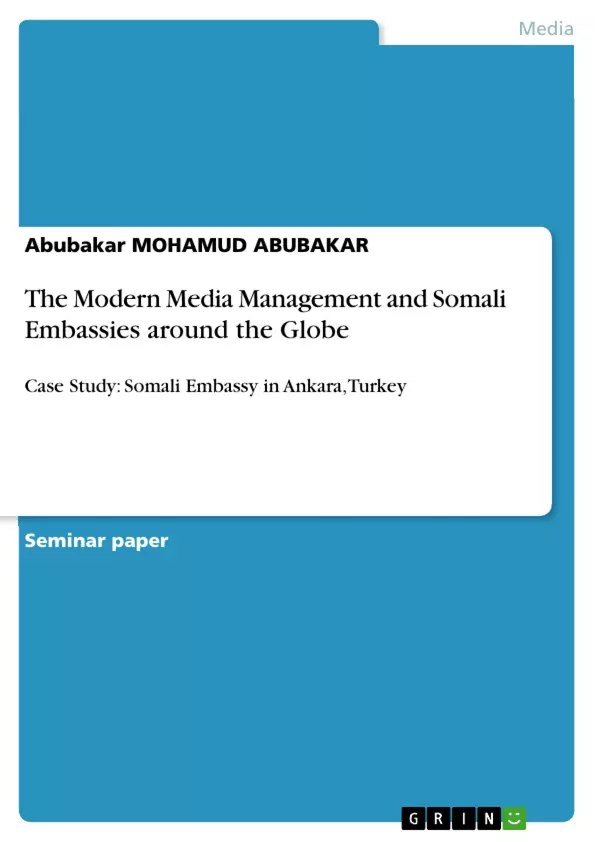For Somalia, the usage of mass media particularly websites in governmental institutions have expanded at significant rates over the past several years, institutions related to the foreign policy have provided significant development to management of the modern media and subsequently it’s rising from the ashes of the pre-war media system.(...) In this paper, I will be trying to examine the management of mass media particularly websites at Somali Foreign Embassies, I will be using Somali Embassy in Ankara, Turkey as a case study.
Inhaltsverzeichnis (Table of Contents)
- INTRODUCTION
- STUDY QUESTIONS
- MODEL
- STUDY DESIGN AND METHODOLOGY
- SOURCES
- DATA COLLECTİON
- FINDINGS AND DISCUSSIONS
- RQ1. How is the current website of the Somali Embassy practice and handle the communication management of the Embassy with their stakeholders?
- RQ2. What communication models is the embassy mostly employs in its website to inform its publics?
- RQ3. What are the activities does the embassy website perform?
- CONCLUSIONS
Zielsetzung und Themenschwerpunkte (Objectives and Key Themes)
This paper aims to examine the management of mass media, specifically websites, at Somali foreign embassies. It uses the Somali Embassy in Ankara, Turkey, as a case study to explore how the embassy utilizes its website for communication management with stakeholders.- Website Management and Communication
- Communication Models Employed by the Embassy
- Activities Performed by the Embassy Website
- Feedback Mechanisms and Stakeholder Engagement
- Modern Media Management in the Context of Somali Embassies
Zusammenfassung der Kapitel (Chapter Summaries)
- INTRODUCTION: This section sets the context by discussing the growth of modern mass media in the 20th and 21st centuries. It highlights the particular focus on Somalia and its evolving media landscape, emphasizing the role of newly emerged institutions, such as foreign embassies, in media management and development.
- STUDY QUESTIONS: This chapter outlines the key research questions that guide the study. These questions focus on how the Somali Embassy in Ankara utilizes its website for communication management, the communication models it employs, and the specific activities the website performs.
- MODEL: This section emphasizes the crucial role of websites as communication tools for information sharing and feedback collection, highlighting their potential to enhance communication within organizations and with stakeholders.
- STUDY DESIGN AND METHODOLOGY: The methodology employed is described, focusing on a quantitative approach with a case study of the Somali Embassy in Ankara. The data collection methods, including face-to-face interviews with embassy officials and staff, are outlined.
- SOURCES: The study utilizes a review of academic journals and publications on public relations practices, providing a theoretical foundation for the analysis.
- DATA COLLECTİON: The data collection process through face-to-face interviews is detailed, including the specific questions asked and the types of data collected from embassy personnel.
- FINDINGS AND DISCUSSIONS: The chapter delves into the findings of the study, answering the research questions. It examines the embassy's communication management practices, communication models, and website activities. The chapter also discusses the embassy's efforts to receive and address stakeholder feedback.
Schlüsselwörter (Keywords)
The study focuses on the key themes of modern media management, website communication, stakeholder engagement, and public relations practices within the context of Somali embassies, specifically the Somali Embassy in Ankara, Turkey. It explores communication models, website activities, feedback mechanisms, and the embassy's efforts to manage and develop its online presence in the evolving media landscape.
Excerpt out of 6 pages
- scroll top
- Quote paper
- Abubakar MOHAMUD ABUBAKAR (Author), 2012, The Modern Media Management and Somali Embassies around the Globe, Munich, GRIN Verlag, https://www.grin.com/document/204219
Look inside the ebook



